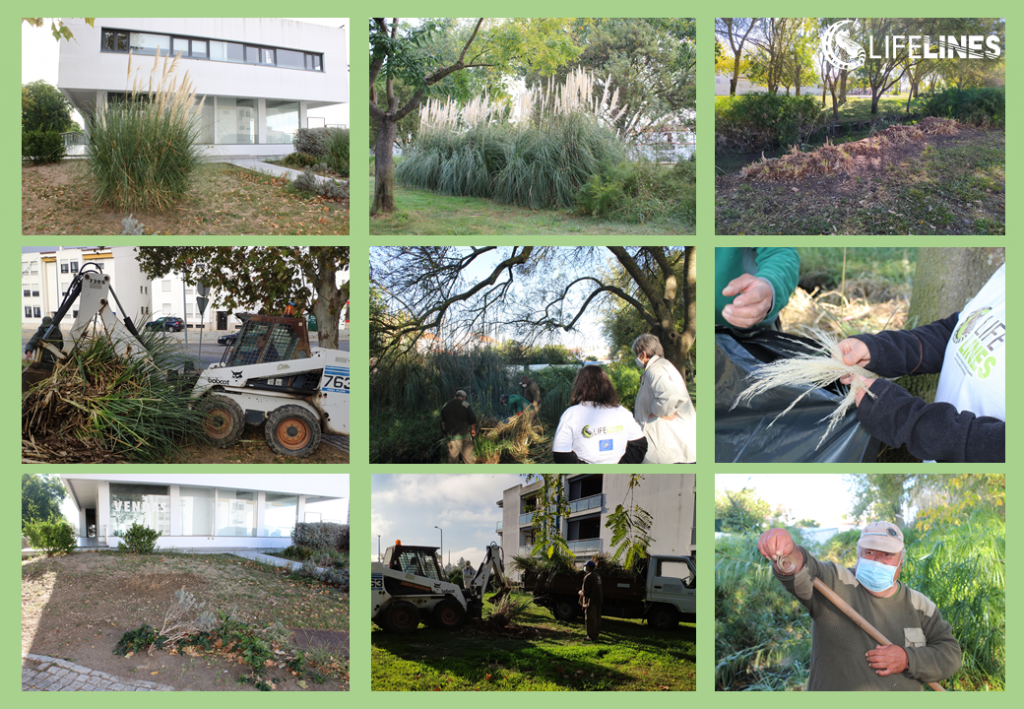Action to remove Pampas grass (Cortaderia selloana) in the city of Évora promoted by LIFE LINES as part of the 1st National Week on Invasive Species
NIGHT OF THE DARK CREATURES 2020 | ONLINE
2020-10-29New paper published under the LIFE LINES Project
2020-11-11Cortaderia selloana – A hidden danger
Showy and exuberant, so are the plumes of Pampas grass (Cortaderia selloana). However, often used for ornamentation, they hide some dangers. In Portugal, it is an exotic species [not from our territory] and invasive [species that dominates the ecosystem, unbalancing its functioning]. To these characteristics are added yet others, equally unfavorable, as they have great allergenic potential, their leaves can cause cuts and have a very high dispersion capacity, since each plume can have thousands of very light seeds [see more information in http://stopcortaderia.org/language/pt/descricao-da-especie/]. Although its potential invader has been detected for a long time, this species only integrated for the first time the legislation on invasive alien species in Portugal in July 2019 through Decreto-Lei nº 92/2019.
Cortaderia selloana removal action promoted by LIFE LINES – how it came about
A few days before the awareness action on “Control of exotic and invasive flora species in the LIFE LINES project” promoted by the project, on October 15th 2020, within the scope of the 1st National Week on Invasive Species (SNEI) we received a comment from a follower of the LIFE LINES page with an alert about the presence of Pampas grass in a green area of the city of Évora. Although the control of this invasive species (and in particular in this location) does not fall within the direct scope of the LIFE LINES project, we did not want to remain indifferent! Thus, the flora team at the University of Évora (through the LIFE LINES project) and the Évora City Council (challenged by Vila Nova de Gaia Council, which is a partner in LIFE STOP CORTADERIA) came together to operationalize the removal of several cores of Pampas grass identified in public green spaces in Évora. The Portuguese team of the LIFE STOP CORTADERIA project was also contacted, in order to provide some guidelines for the effective removal of plants.
On the 15th of October, the first removal action took place, with the work being extended in other places for more days and thus being concluded at the end of October. In total, 7 plant cores were identified (accounting for more than 300 plumes), distributed over three locations in the city. All the plants were cut with plumes (which no longer had seeds at the time) and the youngest plants and those whose removal did not cause problems of instability of the ground were removed by the root. Precisely for this reason, the Torregela cores, with very large adult plants located on the embankment of a water line, were only subject to control (cut).
Help fight the problem – APP LIFE STOP CORTADERIA
One of the simplest ways that all citizens have to help in the fight against this invasive species is through its mapping. For this, LIFE STOP CORTADERIA has developed an android application that allows any citizen to contribute in a simple and intuitive way with their sightings of Pampas grass to achieve one of the objectives of the LIFE STOP CORTADERIA project: “Only with the knowledge of the distribution of this invasive plant, it is possible to define concrete management and control measures for this species, for which the contribution of all citizens is essential ”.
More information about the APP LIFE STOP CORTADERIA here
Curiosity
During this action there was still time to learn from the olders! According to one of the CME operatives, they used to call Pampas grass, the “riddles”. This is because the dry leaves of this plant that form a small roll (as shown in the photo by the CME operative) were hung in the houses and when they started to unfold (due to the humidity) it was a sign that rainy days were coming.

Photo credits | Anabela Belo e Sofia Eufrázio
